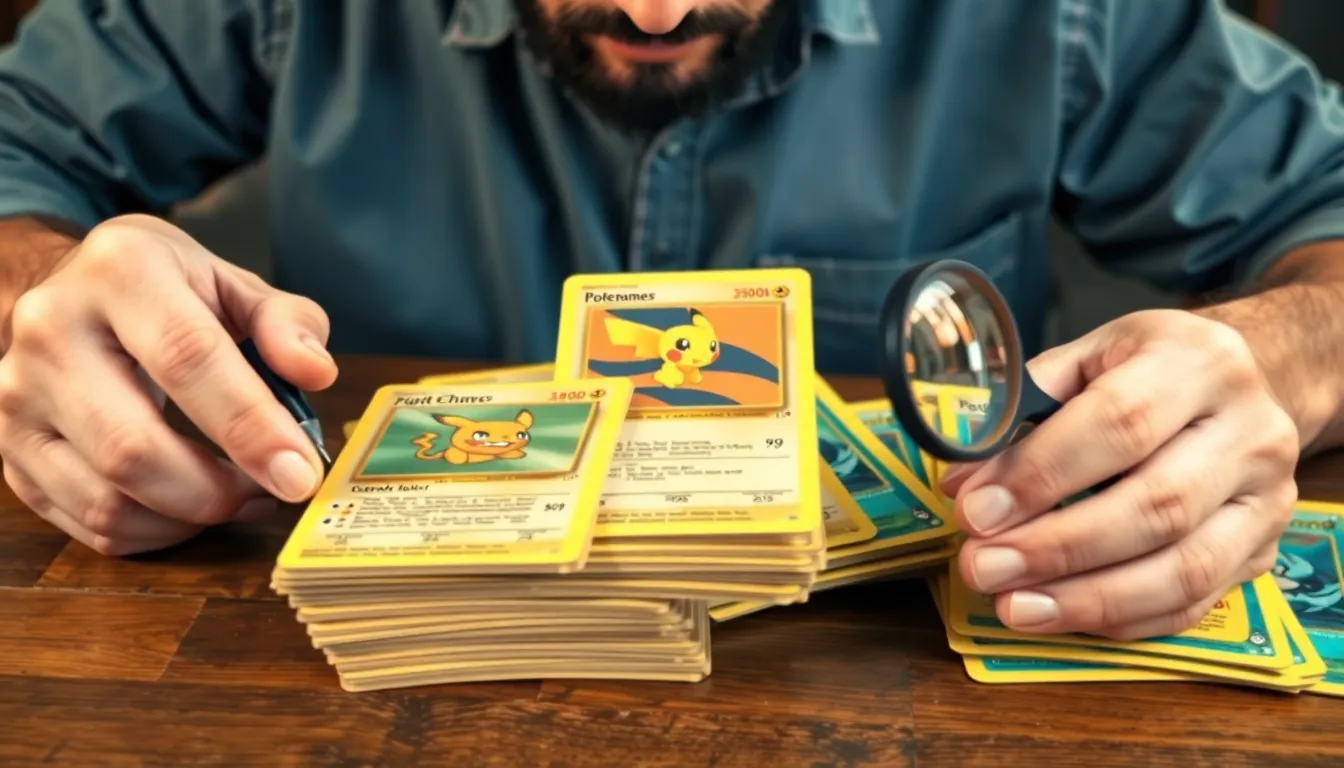Every Pokémon card collector knows the thrill of flipping through their deck, hoping to discover a hidden gem. But how can one tell if that dusty Charizard in the back is worth more than a trip to the local coffee shop or just a few cents? The world of Pokémon card valuation can feel like a wild battle between Pikachu and a Snorlax.
Table of Contents
ToggleUnderstanding Pokémon Card Value
Determining the worth of a Pokémon card involves various factors that collectors must consider. Card value isn’t always straightforward, and certain elements play a pivotal role in valuation.
Factors That Influence Value
Condition significantly affects a card’s worth. Cards graded at higher levels by PSA or BGS fetch more in the market. Popularity also plays a role; fan-favorite Pokémon often see increased demand, which raises values. Edition matters too. First Edition cards typically command higher prices compared to unlimited editions. The card’s playability in competitive settings can also enhance its value. Collectors often seek cards that offer viable strategies in official tournaments.
Rarity and Scarcity
Rarity directly influences how much a card is worth. Cards with limited print runs become more desirable to collectors. Scarcity adds another layer; holographic and shiny cards typically attract higher prices because of their availability. Event promo cards issued during tournaments or exclusive releases are rare and often valued more significantly. The significance of a card, whether it features a popular character or has historical relevance, can also escalate its market value.
Ways to Determine Your Pokémon Card’s Worth

Several methods exist to accurately gauge a Pokémon card’s worth. Understanding these approaches ensures collectors make informed decisions.
Professional Grading Services
Professional grading services, such as PSA and BGS, provide reliable assessment options. Grading evaluates a card’s condition and authenticity, significantly influencing market value. Higher grades attract higher prices, as collectors seek quality cards. A Mint 10 grade often fetches substantially more than a card graded lower. Submitting cards for professional grading incurs fees, but the outcome often justifies the investment. Collectors can check the grading scales on service websites for clarity on valuation standards.
Online Price Guides and Marketplaces
Online price guides and marketplaces offer current market insights. Websites like TCGPlayer and eBay track sales trends, helping collectors establish card worth. Listings reflect actual sales and average prices for various Pokémon cards. Regularly checking these platforms helps keep up with fluctuating market values. Additionally, specific cards may reach higher prices based on demand, rarity, and condition, which varies seasonally or during events. Combining multiple resources provides a comprehensive view of potential card worth.
Comparing Sales and Auction Trends
Understanding recent sales data and auction insights provides valuable context for evaluating Pokémon card worth. These factors help collectors navigate the dynamic market.
Recent Sales Data
Recent sales data reveals trends affecting Pokémon card prices. TCGPlayer’s platform records thousands of transactions daily, showcasing real-time price fluctuations. For instance, Charizard cards frequently sell for prices ranging from $300 to over $2,000 depending on condition and rarity. Analyzing sales of specific cards like First Edition holographics offers deeper insight into market demand. Collectors can leverage this data to identify high-value cards in their collection. It’s critical to track fluctuations, as market values can shift based on growing collector interest or new game mechanics.
Auction House Insights
Auction houses also provide significant insights into Pokémon card valuations. Houses like Heritage Auctions or PWCC MarketPlace regularly feature high-profile sales, garnering attention from serious collectors. Many cards sold at auction exceed retail prices, especially those graded by PSA or BGS with a high numerical grade. Recent auction results show that rare cards can achieve record-breaking prices, underscoring demand. Bidding wars often occur for sought-after cards like Shadowless or trophy cards, driving prices higher. Monitoring these auction results helps collectors assess worth and recognize emerging trends in the marketplace.
Tips for Selling Your Pokémon Cards
Selling Pokémon cards involves thoughtful strategies. Understanding your options can maximize profitability.
Best Platforms for Selling
Online marketplaces like eBay and TCGPlayer serve as primary platforms for selling Pokémon cards. Both platforms attract a vast audience of collectors and offer features to set competitive prices. Facebook groups dedicated to card trading allow for direct transactions with buyers, often yielding better deals. Sellers can utilize marketplaces like Troll and Toad for a focused community of enthusiasts. Auction houses like Heritage Auctions enable selling high-value cards, attracting serious bidders. Each platform presents unique advantages, so choosing the right one based on the card’s value and target audience enhances selling potential.
Pricing Strategies
Determining an effective pricing strategy is essential for selling Pokémon cards. Researching completed sales on platforms like eBay provides a benchmark for competitive pricing. Setting prices slightly below market value can spark buyer interest and encourage quick sales. Offering bulk discounts for multiple card purchases can also attract collectors looking to expand their collections. Additionally, utilizing pricing guides can help in establishing a fair starting price. Keeping a close eye on market trends and being flexible with pricing can lead to successful transactions.
Understanding the worth of Pokémon cards is essential for collectors aiming to make informed decisions. By considering factors like condition rarity and market trends collectors can navigate the complexities of card valuation. Utilizing resources such as professional grading services and online marketplaces enables a clearer picture of a card’s potential value.
As the Pokémon card market continues to evolve staying updated on recent sales and auction results will enhance a collector’s ability to assess their collection. With thoughtful strategies for buying and selling collectors can maximize their investments and enjoy the thrill of this vibrant hobby. Embracing the journey of discovering card values can lead to exciting opportunities and rewarding experiences in the world of Pokémon collecting.





